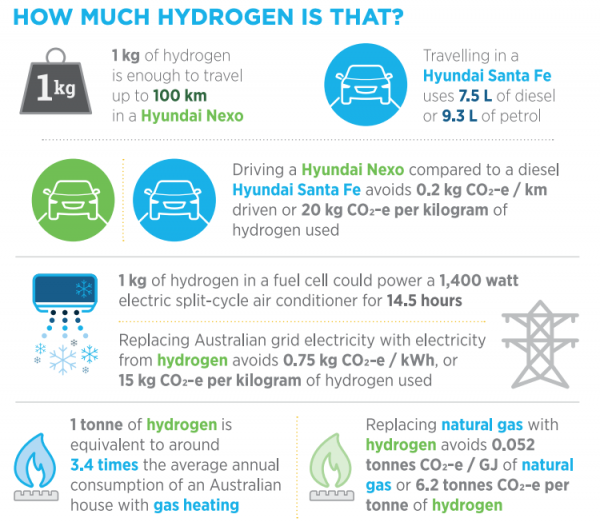Hydrogen is the lightest and most abundant element making up around 75 per cent of the universe’s mass. Hydrogen typically exists in gas form, water or organic compounds and is a key element of hydrocarbons.
Hydrogen is produced using electrolysis to split water into its constituent parts of oxygen and hydrogen. It is highly flammable and can either be used as a combustion fuel or converted to electrical energy by a chemical reaction in a fuel cell as well as having other non-energy uses. Hydrogen has a higher energy density by mass than fossil fuels.
It takes approximately 54kWh and 9 litres of water to produce 1kg of Hydrogen. It is useful for energy storage as it can be produced during times of excess electricity generation and can be stored or distributed as a liquid or gas.
Queensland Hydrogen Strategy Vision: by 2030, Queensland is at the forefront of renewable hydrogen production in Australia, supplying an established domestic market and export partners with a safe, sustainable and reliable supply of hydrogen.
Australia’s National Hydrogen Strategy notes that Queensland is well placed for renewable hydrogen production with significant renewable energy resources and existing and planned renewable energy projects. The Australian Government estimates that the Australian hydrogen industry could be worth $11B and employ over 8,000 people by 2030.
The Commonwealth Government is keen to develop the $70M hydrogen industry in Australia. In April 2020 the Australian Renewable Energy Agency (ARENA) released the Hydrogen Deployment Funding Round to stimulate investment in the production of hydrogen with electrolysers greater than 5MW, sourcing only renewable energy with the aim of reducing the cost to $2 per kilogram, which is considered the price at which it is competitive. The Clean Energy Finance Corporation has also announced an Advancing Hydrogen Fund, with up to $300M in loans available for new hydrogen projects.
There is a significant amount of research and development into Hydrogen production and use. Government and industry are optimistic that over time, Australia could build the industry to provide storage for renewable energy in Australia and to export green hydrogen to Asia.
There are a number of projects testing the Feasibility of blending Hydrogen into natural gas networks in South Australia and Victoria and injecting hydrogen onto the natural gas grid in NSW.
Hydrogen Terminology
- Renewable or Green Hydrogen is hydrogen produced using renewable energy.
- Blue Hydrogen is produced from natural gas, usually via steam-reforming, with carbon capture storage (CCS).
- Brown Hydrogen is produced from coal-fired electricity.
At the Farm scale, vehicle manufacturers such as New Holland are developing prototype tractors that run on hydrogen derived from ammonia and Neil Thompson of ITM Power mentioned at the 2019 Renewable in Agriculture Conference that there are many smaller scale options for farm including small scale electrolysers and fuel cell farm vehicles.
In the agriculture supply chain, a number of large projects are underway including the Gladstone integrated abattoir which aims to provide its own energy with 78MW of solar capacity and a 33MW hydrogen plant to be built. There are also two Queensland projects which aim to produce green hydrogen for ammonia from a 150MW electrolyser powered by a 220MW Solar array at Moura and a 160 MW electrolyser powered by a 210MW solar array Moranbah.
There is a significant amount of research and development into technologies to efficiently produce hydrogen on-farm, such as plasmalysis to generate hydrogen from the nitrogen and carbon compounds (e.g. ammonium) in manure. In Australia, researchers are testing whether bacteria could produce bio-Hydrogen, while there are also companies developing hydrogen storage technologies.
A number of major Motorcycle, Car, Truck and Engine manufacturers are developing hydrogen combustion or fuel cell vehicles as well as investigating the potential for injection into diesel engines. In New Zealand, a prototype fuel call Quadbike has been developed.
It might not be long before hydrogen is an affordable and practical option for use on farms. A number of practical uses in the near future could include:
- On-farm solar systems produce to hydrogen with an electrolyser for when the system isn’t supplying power to a pump or shed – for example when irrigation systems are not being used and export to the grid is unavailable.
- Conversion of farm vehicles and generators to fuel cells to utilise on-farm hydrogen
- Production of hydrogen from animal wastes, for use in heating systems, or in a fuel cell to provide power for lighting and ventilation.

What Next?
We held a webinar on Hydrogen with Dr Neil Thompson in May 2020, see a recording and download the slides HERE.
Subscribe to our bi-monthly energy e-news HERE.
If you have any energy efficiency related questions for the team get in touch at energysavers@qff.org.au.

Image from page xv Australia’s National Hydrogen Strategy